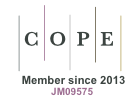Assessment of the Value of Stomatal Size and Density as Hallmarks of Nonaploid Kiwifruit Plants
Abstract
Keywords
References
Antoniazzi, C. A., Faria, R. B., de Carvalho, P. P., Mikovski, A. I., de Carvalho, I. F., de Matos, E. M., Reis, A. C., Viccini, L. F., Pinto, D. P. P., Rocha, D. I., Otoni, W. C., & da Silva, M. L. (2018). In vitro regeneration of triploid plants from mature endosperm culture of commercial passionfruit (Passiflora edulis Sims). Scientia Horticulturae, 238, 408–425. https://doi.org/10.1016/j.scienta.2018.05.001
Beaulieu, J. M., Leitch, I. J., Patel, S., Pendharkar, A., & Knight, C. A. (2008). Genome size is a strong predictor of cell size and stomatal density in angiosperms. New Phytologist, 179, 975–986. https://doi.org/10.1111/j.1469-8137.2008.02528.x
Boase, M. R., & Hopping, M. E. (1995). DNA dodecaploid plants detected among somaclonal of Actinidia deliciosa var. deliciosa cv. Hayward. Plant Cell Reports, 14, 319–323. https://doi.org/10.1007/BF00232036
Chłosta, I., Kwolek, D., Sliwinska, E., Góralski, G., & Popielarska-Konieczna, M. (1921). Sex-linked molecular markers identify female lines in endosperm-derived kiwifruit callus and in regenerants. Plants, 10, Article 526. https://doi.org/10.3390/plants10030526
Cramer, C. S. (1999). Laboratory techniques for determining ploidy in plants. HortTechnology, 9(4), 594–596. https://doi.org/10.21273/HORTTECH.9.4.594
Dirihan, S., Terho, P., Helander, M., & Saikkonen, K. (2013). Efficient analysis of ploidy levels in plant evolutionary ecology. Caryologia, 66(3), 251–256. https://doi.org/10.1080/00087114.2013.849414
Góralski, G., Popielarska, M., Ślesak, H., Siwińska, D., & Batycka, M. (2005). Organogenesis in endosperm of Actinidia deliciosa cv. Hayward cultured in vitro. Acta Biologica Cracoviensia, Series Botanica, 47, 121–128.
Hata, S., Yomo, T., & Fujita, S. (2001). Breeding of triploid plants of stevia (Stevia rebaudiana BERTONI) with high rebaudioside A content. Japanese Journal of Tropical Agriculture, 45, 281–289. https://doi.org/10.11248/jsta1957.45.281
Huang, H. (2016). Introduction. In H. Huang (Ed.), Kiwifruit: The genus Actinidia (pp. 1–7). Academic Press. https://doi.org/10.1016/B978-0-12-803066-0.09999-8
Kadota, M., & Niimi, Y. (2002). In vitro induction of tetraploid plants from a diploid Japanese pear cultivar (Pyrus pyrifolia N. cv. Hosui). Plant Cell Reports, 21, 282–286. https://doi.org/10.1007/s00299-002-0509-1
Mishra, M. K. (1997). Stomatal characteristics at different ploidy levels in Coffea L. Annals of Botany, 80, 689–692. https://doi.org/10.1006/anbo.1997.0491
Murashige, T., & Skoog, F. (1962). A revised medium for rapid growth and bioassay with tobacco tissue cultures. Physiologia Plantarum, 15, 473–497. https://doi.org/10.1111/j.1399-3054.1962.tb08052.x
Padoan, D., Mossad, A., Chiancone, B., Germana, M. A., & Khan, P. S. S. V. (2013). Ploidy levels in Citrus clementine affects leaf morphology, stomatal density and water content. Theoretical and Experimental Plant Physiology, 25, 283–290. https://doi.org/10.1590/S2197-00252013000400006
Popielarska-Konieczna, M., & Kleszcz, I. (2015). Preliminary studies on plants regenerated from endosperm-derived callus of kiwifruit (Actinidia deliciosa var. deliciosa). Modern Phytomorphology, 7, 55–57. https://doi.org/10.5281/zenodo.160362
Popielarska-Konieczna, M., Kozieradzka-Kiszkurno, M., & Bohdanowicz, J. (2011). Cutin plays a role in differentiation of endosperm-derived callus in kiwifruit. Plant Cell Reports, 30, 2143–2152. https://doi.org/10.1007/s00299-011-1120-0
Przywara, L., Pandey, K. K., & Sanders, P. M. (1988). Length of stomata as an indicator of ploidy level in Actinidia deliciosa. New Zealand Journal of Botany, 26, 179–182. https://doi.org/10.1080/0028825X.1988.10410110
R Core Team. (2018). R: A language and environment for statistical computing [Computer software]. R Foundation for Statistical Computing. https://www.R-project.org/
Richardson, D. P., Ansell, J., & Drummond, L. N. (2018). The nutritional and health attributes of kiwifruit: A review. European Journal of Nutrition, 57, 2659–2676. https://doi.org/10.1007/s00394-018-1627-z
Thomas, T. D., Bhatnagar, A. K., & Bhojwani, S. S. (2000). Production of triploid plants of mulberry (Morus alba L.) by endosperm culture. Plant Cell Reports, 19, 395–399. https://doi.org/10.1007/s002990050746
Touchell, D. H., Palmer, I. E., & Ranney, T. G. (2020). In vitro ploidy manipulation for crop improvement. Frontiers in Plant Science, 11, Article 722. https://doi.org/10.3389/fpls.2020.00722
Wang, P., Mu, X., Gao, Y. G., Zhang, J., & Du, J. (2020). Successful induction and the systematic characterization of tetraploids in cerasus humilis for subsequent breeding. Scientia Horticulturae, 265, Article 109216. https://doi.org/10.1016/j.scienta.2020.109216
Wickham, H. (2016). ggplot2: Elegant graphics for data analysis. Springer International Publishing. https://doi.org/10.1007/978-3-319-24277-4
DOI: https://doi.org/10.5586/asbp.909
|
|
|








